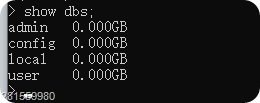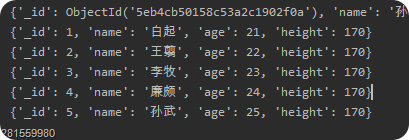insert: 插入数据
简要说明
MongoDB中不支持库和集合单独的创建,也就是无法创建一个空的集合。
如果你进入的这个库或是这个集合是一个新的,那么需要在里面添加数据才能进行保留。
一、基本使用
1、判断数据库是否存在
代码如下:
# coding:utf8 import pymongo as p client = p.MongoClient("mongodb://localhost:27017") s1 = input("检查数据库是否存在,请输入") if s1 in client.list_database_names(): print("数据库已经存在") else: print("数据库不存在,可以使用")
client.list_database_names() 列出当前连接中的所有数据库。
2、判断集合是否存在
代码如下:检查指定的集合是否在local库里
# coding:utf8 import pymongo as p client = p.MongoClient("mongodb://localhost:27017") db = client["local"] s = input("请输入检查的集合名") if s in db.list_collection_names(): print("集合已经存在") else: print("集合不存在,可以使用")
db.list_collection_names()列出当前数据库下所有的集合
3、插入单条数据
我们创建一个新的数据库叫love,里面有一个集合users
代码如下:
# coding:utf8 import pymongo as p # 链接数据库 client = p.MongoClient("mongodb://localhost:27017") # 进入数据库, 这个数据库和集合其实不存在,我们进入它然后插入一条数据,它就存在了。 mydb = client["love"] student = mydb["users"] # 插入的数据其实就是字典 dict1 = {"name": "白起", "age": 20, "height": 170} x = student.insert_one(dict1) # 打印插入数据的id、users集合 print(x.inserted_id) for v in student.find(): print(v)
运行结果:
4、插入多条数据
代码如下:
# coding:utf8 import pymongo as p # 链接数据库 client = p.MongoClient("mongodb://localhost:27017") # 进入数据库, 这个数据库和集合其实不存在,我们进入它然后插入一条数据,它就存在了。 mydb = client["love"] student = mydb["users"] # 插入的数据其实就是字典 list1 = [{"name": "白起", "age": 21, "height": 170}, {"name": "王翦", "age": 22, "height": 170}, {"name": "李牧", "age": 23, "height": 170}, {"name": "廉颇", "age": 24, "height": 170}, {"name": "孙武", "age": 25, "height": 170}] # 插入多条数据 x = student.insert_many(list1) # 打印插入数据的id、users集合 print(x.inserted_ids) for v in student.find(): print(v)
运行结果:
5、插入的id是可以自定义的,不设置则系统会自动生成。
代码如下:
# coding:utf8 import pymongo as p # 链接数据库 client = p.MongoClient("mongodb://localhost:27017") # 进入数据库, 这个数据库和集合其实不存在,我们进入它然后插入一条数据,它就存在了。 mydb = client["love"] student = mydb["users"] # 插入的数据其实就是字典 list1 = [{"_id": 1, "name": "白起", "age": 21, "height": 170}, {"_id": 2, "name": "王翦", "age": 22, "height": 170}, {"_id": 3, "name": "李牧", "age": 23, "height": 170}, {"_id": 4, "name": "廉颇", "age": 24, "height": 170}, {"_id": 5, "name": "孙武", "age": 25, "height": 170}] # 插入多条数据 x = student.insert_many(list1) # 打印插入数据的id、users集合 print(x.inserted_ids) for v in student.find(): print(v)
运行结果:
读书和健身总有一个在路上



